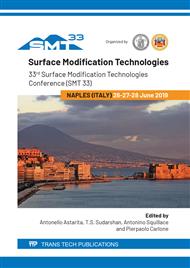p.1
p.7
p.13
p.19
p.25
p.31
p.37
p.43
Improvement of Hydrophobic Property of Stainless-Steel Plates by Forming Lens-Like Protrusions Similar to Oxalis Leaf Surfaces
Abstract:
Leaves of an obscure plant “oxalis deppei” are so hydrophobic that showered water droplets are almost completely repelled and hardly remained on their surfaces. For this reason, surface configurations were investigated. On the live leaves, there formed protrusions somewhat similar to those observed on lotus leaves which are well known as super hydrophobic leaves. However, in winter, it was found that even dead leaves were hydrophobic also. Because leaf tissues were shriveled and dried half, heights of protrusions with sizes of 20-50 μm were low, and undulations of surfaces were gentle and smooth, and pitches of undulations were as large as 30-70 μm. It was thought that such gentle lens-like protrusions would be probably formed on versatile stainless-steel plates using lithography and wet chemical etching. For this reason, arrays of protrusions with a size of 20 μm, a pitch of 35 μm, and heights of 6-7 μm were formed, and change of hydrophobic properties were investigated. As a result, the hydrophobic properties were effectively improved by forming even such gentle and smooth protrusions. It was also clarified that contact angles were improved almost in proportion to etched depths.
Info:
Periodical:
Pages:
19-24
Citation:
Online since:
July 2019
Price:
Сopyright:
© 2019 Trans Tech Publications Ltd. All Rights Reserved
Share:
Citation:


